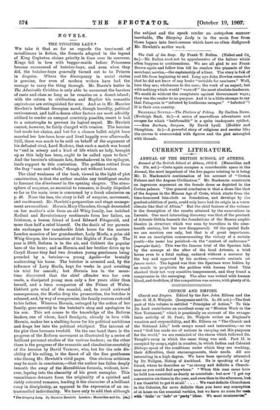C IIRRENT LITE RAT (IRE.
ANNUAL OF THE BRITISH SCHOOL AT ATHENS.
Annual of the British School at Athens, 1905-6. (Macmillan and Co. 25s. net.)—Crete again occupies a considerable space in the Annual, the most important of the five papers relating to it being Mr. D. Mackenzie's continuation of his account of "Cretan Palaces and the Aegean Civilization." Mr. Mackenzie constructe an ingenious argument on the female dress as depicted in the- Cretan palaces. "Our general conclusion is that a dross like that. ofthe Aegean in the Minoan Age of Crete, which starts from the time-honoured loin-cloth as foundation, and develops by the- gradual addition of parts, could only have had its origin in a warm climate like that of Africa." But the chief feature of the volume is the description of the results attained by the excavations in Laconia. One most interesting discovery was that of the precinct of Artemis Orthia beneath the foundations of the Roman amphi- theatre (a structure which was seen by travellers in the nine- teenth century, but has now disappeared). Of the special finds we can mention one only, but that is of great importance. It was an inscription commemorating the victory of a certain youth—the name has perished—in the "contest of endurance" (Kam-Epics 1:76e). This was the famous trial of the Spartan lads. by the scourge at the altar of the local Artemis, a trial borne even to a fatal ending, endured without a murmur by the boy and approved by his mother,—coronato contents est funere motor. The legend was that the Spartans were bidden by an oracle to propitiate the goddess with human blood. This- shocked their not very sensitive temperament, and they found a compromise in the scourging. The altar was wetted with human blood, and doubtless, if the competition was severe, with plenty of it.










































 Previous page
Previous page